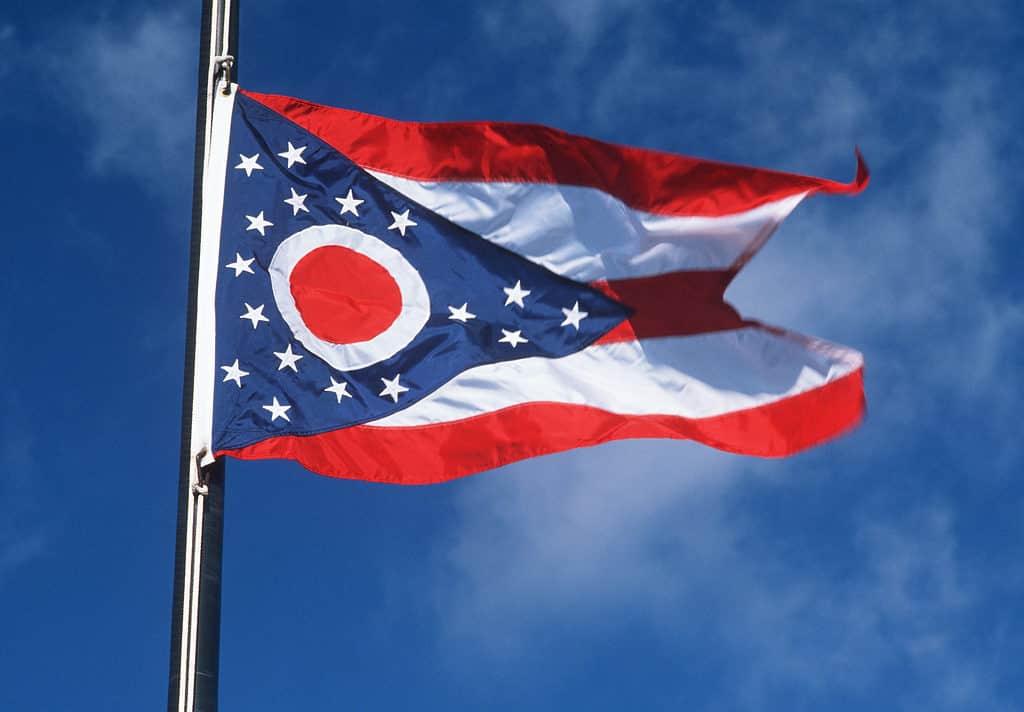Did you know that the current design for the American flag was created by an Ohio resident? At 17 years old, Robert Heft of Lancaster, Ohio designed the current American flag, which was eventually passed by the United States Congress. However, Ohio has another flag to boast about, too. The Ohio state flag is the only state flag to include the swallow-tailed burgee, rather than a rectangular shape. Find out why the Ohio flag remains unique and symbolic to this day.
Founding of Ohio
Ohio was settled in 1788 by a group of expeditioners that were sent to the territory by the Ohio Company. They first settled in the modern-day city of Marietta next to the Ohio River. Settlers expanded further into Ohio when General Anthony Wayne proposed the Treaty of Greenville to Native Americans living in Ohio in 1795. This treaty meant that settlers could move to other areas of the Northwest Territory, including toward the east and toward the south.
In 1799, Cincinnati hosted the first legislative meeting in Ohio. Four years later, Ohio was recognized as the 17th state of the United States of America. The capital of Ohio changed many times over several years. The first capital was Chillicothe, a term deriving from the Shawnee word “Chalahgawtha,” which means “principal town.” However, the capital was moved to Zanesville in 1810, back to Chillicothe until 1816, and finally to Columbus, Ohio. Columbus remains the capital of Ohio to this day.

Columbus became the capital of Ohio in 1816.
©iStock.com/TraceRouda
Characteristics and Fun Facts of Ohio
Ohio measures 44,825 square miles in area. As of 2010, its population numbered over 11.5 million residents. Ohio’s name derives from the Iroquois term “O-Y-O,” which means “great river.” Originally, the Iroquois people were prevalent throughout Ohio until white settlers and treaties pushed them out of their home.
Ohio has been nicknamed the “Buckeye State” for its buckeye trees. Buckeye trees produce a fruit that Native Americans believed looked like the eye of a male deer, or a buck’s eye. A notable piece of information about Ohio is that many call it the “Mother of Modern Presidents.” Seven United States presidents were born in Ohio, including famous Civil War figure Ulysses S. Grant.
Ohio’s climate mirrors that of the Midwest and Eastern United States. During the summer, temperatures range from 60ºF to 80ºF. In the winter, temperatures lie between 20ºF and 30ºF. Snowfall is abundant and common in Ohio, especially in the northeastern region of the state. Warm, wet fronts from the Gulf of Mexico and cold, dry fronts from Canada combine in Ohio to produce an average of 40 inches of annual precipitation and 28 inches of snowfall. However, Northeast Ohio can experience more than 100 inches of annual snowfall.
Many people envision Ohio’s topography and plant life as nothing more than flat farmland. While this is partially true, it wasn’t always this way. Forests used to cover a sizeable portion of the state until they were cut down by settlers, lumber producers, and farmers. However, efforts have been made to replenish these forests in the state, which have proved successful. Important tree species that remain in Ohio include oak, maple, hickory, and walnut, to name a few. Most prominent of all, though, is the Ohio buckeye, which is the state’s official tree.
Animal life in Ohio consists of many different types of bird and fish species. Over 350 bird species reside within the state, and half of these are considered native species. On the other hand, 150 fish species swim throughout Ohio streams, rivers, and tributaries. Some of these are the bass, trout, and perch. Furthermore, deer, foxes, raccoons, and skunks inhabit the state. While beaver and wild turkey groups have had low population numbers in the past, these animal populations have been replenished through conservation efforts.

The Ohio buckeye is Ohio state’s official tree.
©CountryGirl624/Shutterstock.com
History and Symbolism of the Flag of Ohio
The flag of Ohio was designed by architect John Eisenmann, who chose to shape Ohio’s flag in an unconventional fashion. He implemented the swallow-tailed burgee into the design of the Ohio state flag. A swallow-tailed burgee is a flag shape that is not rectangular. Rather, the burgee is shaped almost like the beak of a bird–open-mouthed–or the fin of a fish drawn by a novice artist.
Ohio Legislature approved the flag design on May 9, 1902. There are three red horizontal stripes accompanied by two white horizontal stripes between the red stripes. According to Eisenmann, the stripes signify roads and waterways within the state. On the left-most side of the flag is a blue triangle, whose pinnacle vertex points toward the right side of the flag. The flag’s triangle represents hills and valleys. Within the Ohio state flag lie 13 white stars that surround the inner red and white bullseye-looking circle. The 13 stars represent the 13 original colonies and states in the United States and the Northwest Territory. Four other stars on the flag were added by Eisenmann to signify Ohio’s ratification as the 17th state of the United States. The white and red bullseye is shaped like an O for “Ohio” and alludes to Ohio’s tagline as the Buckeye State.
The flag of Ohio was first flown at the Pan-American Exposition in Buffalo, New York. While this was a great feat for Ohio in their state identity, events took a turn for the worse. President William McKinley, who was born in Ohio, was assassinated during the Pan-American Exposition. Exactly 100 years after the flag of Ohio was introduced, the Ohio General Assembly approved an addendum to the United States pledge of allegiance. Following the national pledge to the American flag, Ohio residents could say the following phrase:
“I salute the flag of the state of Ohio and pledge to the Buckeye State respect and loyalty.”
In the same way that the red, white, and blue colors of the Ohio flag reflect the American flag, the Ohio pledge pays homage to the great country that the state resides in.

The Ohio state flag is the only state flag to include the swallow-tailed burgee, rather than a rectangular shape.
©Joseph Sohm/Shutterstock.com
How to Display the Flag of Ohio
The flag of Ohio should be flown from sunup to sundown every day, on national and state holidays, and on any other days the governor claims it should be flown. The only exception to this rule would be if harsh weather conditions threaten to damage the flag. In this case, the flag may be taken down but should be folded properly following this action. In another case, the flag can be flown after sunset. However, correct lighting is required to illuminate a flag flown at night.
A flag flown outside should be flown from a staff or flagpole, and this fixture should be between 2.5 and three times longer than the length of the flag of Ohio. A damaged flag may be washed or repaired if possible. If a flag cannot be washed or repaired, the flag can be discarded privately in several ways. However, a person that discards the flag of Ohio should do so in a respectful fashion. A few ways to destroy the flag include cutting it into small pieces, burning it to ash, or placing it in a box before throwing it away.
When the flag of Ohio is flown in proximity to the flag of the United States of America, the flag of Ohio should sit lower than the national flag. If this action is not possible, as the flagpoles may be at the same height, the national flag must be put up and taken down before all other state flags join it in being flown. Furthermore, if a group of state flags is flown alongside the American flag, the American flag must remain front and center.
Other Ohio Symbols
While the flag of Ohio might be the state’s greatest representation of state identity, other symbols within the state exist, including plants, artifacts, and animals of all types. Some of these symbols are listed below:
- White-tailed deer
- Cardinal
- Ohio Buckeye
- Ladybug
- Scarlet Carnation
- Adena Pipe
- Paw Paw
- Tomato
Click here to learn about every single flag in the world!
Up Next
- The Flag of Liberia: History, Meaning, and Symbolism
- 29 Different Countries with Red, White, and Blue Flags
- Watch These National Heroes Save a Falling Cat with an American Flag at a Football Game
The photo featured at the top of this post is © iStock.com/Milos Subasic
Sources
- Frank LaRose Ohio Secretary of State, Available here: https://www.ohiosos.gov/globalassets/publications/agency/flag.pdf
- Frank LaRose Ohio Secretary of State, Available here: https://www.ohiosos.gov/profile-ohio/government/ohio-becomes-a-state/#:~:text=In%201803%2C%20Ohio%20was%20admitted,newly%20formed%20state%20of%20Ohio
- History, Available here: https://www.history.com/topics/us-states/ohio
- George W. Knepper, Available here: https://www.britannica.com/place/Ohio-state
FAQs (Frequently Asked Questions)
Where is Ohio located?
Ohio is in the Midwest portion of the United States, bordered by Michigan, Indiana, Kentucky, West Virginia, and Pennsylvania.
Who designed the Ohio state flag?
Architect John Eisenmann designed the flag of Ohio.
When was the flag of Ohio introduced?
Ohio’s state flag was approved by the Ohio Legislature on May 9, 1902. It was first flown at the Pan-American Exposition in Buffalo, New York.
Thank you for reading! Have some feedback for us? Contact the AZ Animals editorial team.






